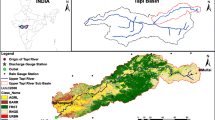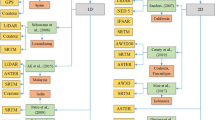Abstract
The objective of this paper is to study the impact of the mesh size of the digital elevation model (DEM) on terrain attributes within an Annualized AGricultural NonPoint Source pollution (AnnAGNPS) Model simulation at watershed scale and provide a correction of slope gradient for low resolution DEMs. The effect of different grid sizes of DEMs on terrain attributes was examined by comparing eight DEMs (30, 40, 50, 60, 70, 80, 90, and 100 m). The accuracy of the AnnAGNPS stimulation on runoff, sediments, and nutrient loads is evaluated. The results are as follows: (1) Rnoff does not vary much with decrease of DEM resolution whereas soil erosion and total nitrogen (TN) load change prominently. There is little effect on runoff simulation of AnnAGNPS modeling by the amended slope using an adjusted 50 m DEM. (2) A decrease of sediment yield and TN load is observed with an increase of DEM mesh size from 30 to 60 m; a slight decrease of sediment and TN load with the DEM mesh size bigger than 60 m. There is similar trend for total phosphorus (TP) variation, but with less range of variation, the simulation of sediment, TN, and TP increase, in which sediment increase up to 1.75 times compared to the model using unadjusted 50 m DEM. In all, the amended simulation still has a large difference relative to the results using 30 m DEM. AnnAGNPS is less reliable for sediment loading prediction in a small hilly watershed. (3) Resolution of DEM has significant impact on slope gradient. The average, minimum, maximum of slope from the various DEMs reduced obviously with the decrease of DEM precision. For the grade of 0∼15°, the slopes at lower resolution DEM are generally bigger than those at higher resolution DEM. But for the grade bigger than 15°, the slopes at lower resolution DEM are generally smaller than those at higher resolution DEM. So it is necessary to adjust the slope with a fitting equation. A cubic model is used for correction of slope gradient from lower resolution to that from higher resolution. Results for Dage watershed showed that fine meshes are desired to avoid large underestimates of sediment and total nitrogen loads and moderate underestimates of total phosphorus loads even with the slopes for the 50 m DEM adjusted to be more similar to the slopes from the 30 m DEM. Decreasing the mesh size beyond this threshold does not substantially affect the computed runoff flux but generated prediction errors for nitrogen and sediment yields. So the appropriate DEM will control error and make simulation at acceptable level.
Similar content being viewed by others
References
Ahmadzadeh, M. R., & Petrou, M. (2001). Error statistics for slope and aspect when derived from interpolated data. IEEE Transactions on Geoscience and Remote Sensing, 39(9), 1823–1833.
Bingner, R. L., & Theurer, F. D. (2005). AnnAGNPS technical processes documentation. Version USDA-ARS.
Brannan, K. J., & Hamlett, M. (1998). Using geostatistics to select gridcell layouts for the AGNPS model. Trans ASAE, 41(4), 1011–1018.
Brasington, J., & Richards, K. (1998). Interactions between model predictions, parameters and DTM scales for topmodel. Computer and Geoscience, 24(4), 299–314.
Brown, D. G., Bian, L., & Walsh, S. J. (1993). Response of a distributed watershed erosion model to variations in input data aggregation levels. Computers and Geosciences, 19(4), 499–509.
Callow, J. N., Van Niel, K. P., & Boggs, G. S. (2007). How does modifying a DEM to reflect known hydrology affect subsequent terrain analysis? Journal of Hydrology, 332(1–2), 30–39.
Chaplot, V. (2005). Impact of DEM mesh size and soil map scale on SWAT runoff, sediment, and NO3 −N loads predictions. Journal of Hydrology, 312(1–4), 207–222.
Chaplot, V., Saleh, A., Jaynes, D. B., & Arnold, J. (2004). Predicting water, sediment and NO3 −N loads under scenarios of land-use and management practices in a flat watershed. Water, Air, and Soil pollution, 154(1–4), 271–293.
Chaplot, V., Walter, C., & Curmi, P. (2000). Improving soil hydromorphy prediction according to DEM resolution and available pedological data. Geoderma, 97(3–4), 405–422.
Chen, N., Wang, Q. M., & Tang, G. A. (2006). The influence of DEM with different resolutions on the precision of the slope extracted in the loess plateau. Journal of Huaqiao University, 27(3), 22–329 (in Chinese).
Cronshey, R. G., & Theurer, F. G. (1998). AnnAGNPS non point pollutant loading model. In Proceedings of the first federal interagency hydrologic modeling conference, 19–23 April, Las Vegas, NV.
Farajall, N. S., & Vieux, B. E. (1995). Capturing the essential spatial variability in distributed hydrological modeling infiltration parameters. Hydrological Processes, 9(1), 55–68.
FitzHugh, T. W., & Mackay, D. S. (2000). Impacts of input parameter spatial aggregation on an agricultural nonpoint source pollution model. Journal of Hydrology, 236(1–2), 35–53.
Gao, J. (1997). Resolution and accuracy of terrain representation by grid DEMs at a micro-scale. International Journal of Geographical Information Science, 11(2), 199–212.
Kao, J.-J., Li, P.-H., Lin, C. L., & Hu, W.-H. (2008). Siting analyses for water quality sampling in a catchment. Environmental Monitoring and Assessment, 139, 205–215.
Kienzle, S. (2004). The effect of DEM raster resolution on first order, second order and compound terrain derivatives. Transactions in GIS, 8(1), 83–111.
Lin, C. E., Kao, C. M., Lai, Y. C., Shan, W. L., & Wu, C. Y. (2009). Application of integrated GIS and multimedia modelling on NPS pollution evaluation. Environmental Monitoring and Assessment, 158, 319–331.
Qin, F. L., Wang, X. Y., Dou, P. Q., & Wang, L. H. (2005). An analysis of the watershed terrain features derived from DEM with different precision and a study of the slope error control. Remote Sensing For Land & Resources, 5(4), 56–59 (in Chinese).
Quinn, P., Beven, K., Chevallier, P., & Planchon, O. (1991). The prediction of hillslope flow paths for distributed hydrological modelling using digital terrain models. Hydrological Processes, 5(1), 59–80.
Tang, G. A., Ge, S. S., Li, F. Y., & Zhou, J. Y. (2005). Review of digital elevation model (DEM) based research on China Loess Plateau. Journal of Mountain Science, 2(3), 265–270.
Tang, G. A., Zhao, M. D., Li, T. W., Liu, Y. M., & Xie, Y. L. (2003). Modeling slope uncertainty derived from DEMs in loess plateau. Acta Geographica Sinica, 58(6), 824–830 (in Chinese).
Tarboton, D. G. (1997). A new method for the determination of flow directions and upslope areas in grid digital elevation models. Water Resources Research, 33(2), 309–319.
Thompson, J., Bell, J., & Butler, C. (2001). Digital elevation model resolution: Effects on terrain attribute calculation and quantitative soil-landscape modeling. Geoderma, 100(1–2), 67–89.
Tian, Y. W., Huang, Z. L., Zeng, L. X., Xiao, W. F., & Ma, D. J. (2009). Impact of DEM mesh size on AnnAGNPS runoff and sediment predictions for a small scale hilly watershed. Acta Scientiae Circumstantiae, 29(4), 846–853 (in Chinese).
Vieux, B. E., & Needham, S. (1993). Nonpoint-pollution model sensitivity to grid-cell size. Journal of Water Resources Planning and Management, 119(2), 141–157.
Wang, X., Li, I., Xu, Q., & He, W. (2001). Study on the distribution of non-point source pollution in the watershed of Miyun reservoir, Beijing, China. Water Science and Technology, 44(7), 35–40.
Wang, X. Y., Wang, Y. X., Guo, F., Cai, X. G., & Hu, Q. J. (2003). Nonpoint source pollution loading from the watersheds of Chaohe River and Baihe River around Miyun Reservoir. Urban Environment and Urban Ecology, 16(2), 31–33 (in Chinese).
Wise, S. M. (2007). Effect of differing DEM creation methods on the results from a hydrological model. Computers & Geosciences, 33(10), 1351–1365.
Wu, S.-S., Usery, E. L., Finn, M. P., & Bosch, D. D. (2008). An assessment of the effects of cell size on AGNPS modelling of water runoff. Cartography and Geographic Information Science, 35(4), 265–278.
Young, R. A., Onstad, C. A., Bosch, D. D., & Anderson, W. P. (1987). AGNPS, agricultural nonpoint source pollution model: A watershed analysis tool. Conservation Research Report, 35, U.S. Department of Agriculture, Agricultural Research Service, Morris, MN, USA.
Zhang, W., & Montgomery, D. R. (1994). Digital elevation model grid size, landscape representation, and hydrologic simulations. Water Resources Research, 30(4), 1019–1028.
Author information
Authors and Affiliations
Corresponding author
Rights and permissions
About this article
Cite this article
Wang, X., Lin, Q. Effect of DEM mesh size on AnnAGNPS simulation and slope correction. Environ Monit Assess 179, 267–277 (2011). https://doi.org/10.1007/s10661-010-1734-7
Received:
Accepted:
Published:
Issue Date:
DOI: https://doi.org/10.1007/s10661-010-1734-7




